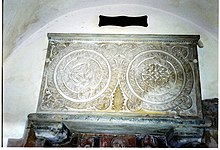Cumianus (c. 641 – c. 736) was an Irish monk who became abbot of San Colombano di Bobbio around 715. He left Ireland as an old man. The intricately carved lid of his sarcophagus, containing a lengthy epitaph, was made by one Master John and commissioned by King Liutprand, King of the Lombards.[1]

The inscription on the tomb reads as follows; it is written in rhythmic hexameters, a kind of hexameter in which word accent is taken into account rather than syllable length:[2]
- Hic sacra beati membra Cumiani solvuntur,
- cuius coelum penetrans anima cum angelis gaudet.
- iste fuit magnus dignitate, genere, forma.
- hunc misit Scotia fines ad Italicos senem:
- locatus Ebobio Domini constrictus amore,
- ubi venerandi dogma Columbani servando
- vigilans, jejunans, indefessus, sedulo orans
- Olympiades quatuor uniusque curriculo anni
- sic vixit feliciter, ut felix modo credatur,
- mitis, prudens, pius, fratribus pacificus cunctis.
- huic aetatis anni fuerunt nonies deni,
- lustrum quoque unum mense(n)sque quatuor simul.
- at pater egregie potens intercessor existe
- pro gloriosissimo Luitprando rege, qui tuum
- pretioso lapide tympum decoravit devotus,
- sit ut manifestum, almum ubi tegitur corpus.
- "Here lie the sacred limbs of Cumian;
- whose soul, entering heaven, rejoices with the angels.
- He was great in dignity, nobility, and beauty.
- Ireland sent him as an old man to the lands of Italy:
- located in Bobbio, constrained by love of the Lord,
- where, by preserving the teaching of the venerable Columban,
- keeping watch, fasting, tireless, constantly praying,
- for four olympiads and the course of one year
- he lived so felicitously that he is believed to be only fortunate,
- gentle, wise, pious, peaceful to all brothers.
- He lived for 90 years
- and one period of five years and four months altogether.
- But, most excellent Father, be a powerful intercessor
- for the most glorious King Liutprand, who
- has devotedly decorated your tomb with precious stone,
- so that it may be manifest where your kindly body is buried."
Notes
edit- ^ Nicholas Everett, Literacy in Lombard Italy, c. 568–774 (Cambridge: Cambridge University Press, 2003), 251–54.
- ^ Thurneysen, R. (1887). "Der Weg vom dactylischen Hexameter zum epischen Zehnsilber der Franzosen.". Zeitschr. f. rom. Phil. XI.; p. 316.